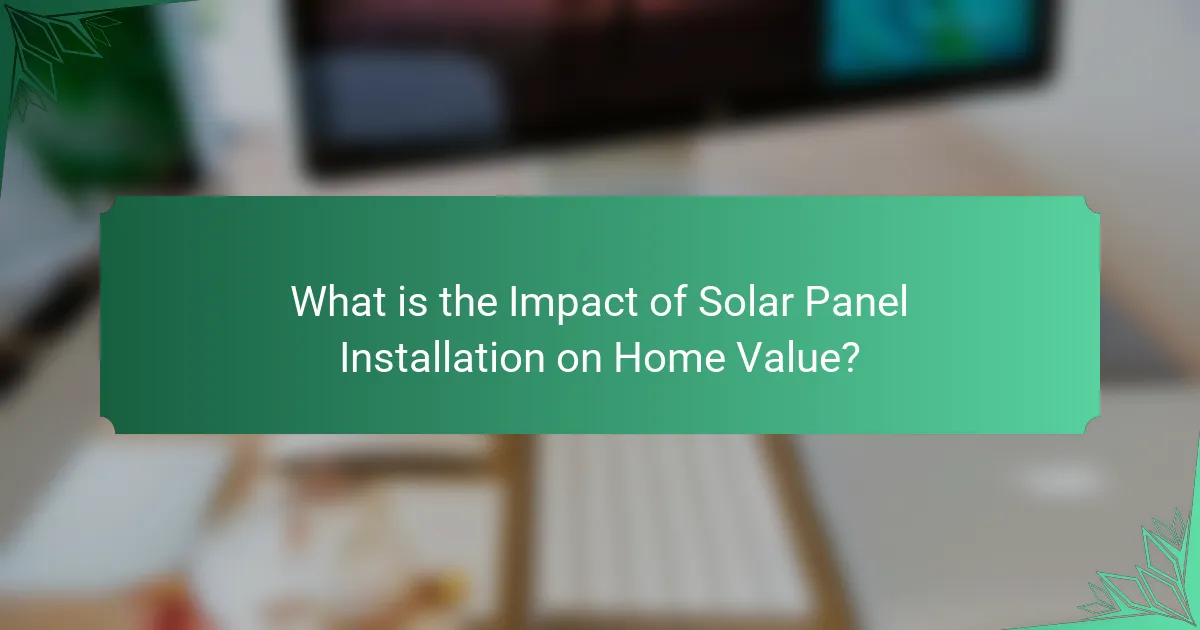
What is Solar Panel Installation and Its Importance?
Solar panel installation refers to the process of setting up solar panels on a building or property to capture sunlight and convert it into electricity. This process is crucial for harnessing renewable energy, reducing electricity bills, and minimizing carbon footprints. According to the U.S. Department of Energy, solar energy can significantly decrease reliance on fossil fuels. Additionally, homes with solar panels often see an increase in property value, as buyers recognize the long-term savings and environmental benefits. The National Renewable Energy Laboratory states that homes with solar installations can sell for 4.1% more on average than comparable homes without solar.
How do solar panels work during installation?
Solar panels convert sunlight into electricity during installation through a series of components. The main components include solar cells, an inverter, and mounting systems. Solar cells absorb sunlight and generate direct current (DC) electricity. The inverter then converts DC electricity into alternating current (AC) electricity for home use. Mounting systems secure the panels to the roof or ground. Proper installation ensures optimal angle and orientation for sunlight exposure. This maximizes energy production and efficiency. According to the U.S. Department of Energy, properly installed solar panels can increase home value by approximately 4.1% on average.
What are the key components of a solar panel system?
The key components of a solar panel system include solar panels, inverters, mounting systems, batteries, and charge controllers. Solar panels convert sunlight into electricity through photovoltaic cells. Inverters transform the direct current generated by the panels into alternating current for home use. Mounting systems securely hold the panels in place on roofs or ground installations. Batteries store excess energy for use during low sunlight conditions. Charge controllers regulate the flow of electricity to and from the batteries, preventing overcharging. These components work together to create an efficient solar energy system.
How does the installation process differ for various types of solar panels?
The installation process differs for various types of solar panels primarily based on their design and mounting requirements. Monocrystalline panels require precise mounting and are typically installed on rooftops or ground mounts with specific angle adjustments for optimal sunlight capture. Polycrystalline panels have similar installation procedures but may have slightly different weight and space considerations. Thin-film solar panels are lighter and more flexible, allowing for easier installation on varied surfaces, including curved roofs. Each type may also require different inverter setups and wiring configurations. The installation complexity can affect labor costs and time, with monocrystalline often being more labor-intensive due to their rigid structure.
What are the main benefits of solar panel installation?
Solar panel installation provides significant benefits such as reduced energy bills, increased home value, and environmental sustainability. By harnessing solar energy, homeowners can lower their electricity costs, often saving 50% or more on monthly utility bills. Additionally, homes equipped with solar panels typically see an increase in property value, with studies indicating an average increase of $15,000. Solar panels also contribute to environmental sustainability by reducing reliance on fossil fuels and decreasing greenhouse gas emissions. According to the U.S. Department of Energy, solar energy systems can reduce carbon dioxide emissions by an average of 100 tons over their lifetime. These benefits make solar panel installation a sound investment for homeowners.
How does solar panel installation contribute to energy savings?
Solar panel installation contributes to energy savings by harnessing sunlight to generate electricity. This reduces reliance on grid power, leading to lower energy bills. In many cases, solar panels can cover a significant portion of a household’s energy needs. According to the U.S. Department of Energy, homeowners can save an average of $10,000 to $30,000 over 20 years with solar panel systems. Additionally, net metering allows homeowners to sell excess energy back to the grid, further enhancing savings. The initial investment in solar panels is often recouped through these savings within a few years. Therefore, solar panel installation is an effective strategy for reducing energy costs.
What environmental benefits are associated with solar panel installation?
Solar panel installation offers significant environmental benefits. It reduces greenhouse gas emissions by decreasing reliance on fossil fuels. According to the U.S. Environmental Protection Agency, solar energy can lower carbon dioxide emissions by approximately 80% compared to traditional energy sources. Solar panels also help conserve water, as they require minimal water for operation. This is crucial since conventional energy production often uses large amounts of water for cooling processes. Additionally, solar energy contributes to air quality improvement by reducing pollutants such as sulfur dioxide and nitrogen oxides. The installation of solar panels promotes sustainable energy practices, supporting a transition to renewable energy sources.

How Do Aesthetics Play a Role in Solar Panel Installation?
Aesthetics significantly influence solar panel installation decisions. Homeowners often prioritize visual appeal when selecting solar systems. Attractive designs can enhance property value and curb appeal. Studies show that well-integrated solar panels can increase home resale value by up to 4%. The choice of panel color and layout affects overall aesthetics. Some homeowners prefer sleek, low-profile designs that blend with the roof. Others may opt for solar shingles that resemble traditional roofing materials. Aesthetic considerations can also impact community acceptance of solar installations. In neighborhoods with strict design guidelines, aesthetics play a crucial role in approval processes.
What design options are available for solar panel installations?
There are several design options available for solar panel installations. These options include roof-mounted systems, ground-mounted systems, and building-integrated photovoltaics (BIPV). Roof-mounted systems are the most common, utilizing existing structures. Ground-mounted systems allow for flexible placement and optimal sun exposure. BIPV integrates solar panels into building materials, enhancing aesthetics. Each design option can be tailored to specific energy needs and site conditions. The choice of design can also impact the overall visual appeal of a property. Statistics show that well-designed solar installations can increase home value by up to 4%.
How can solar panels be integrated into different architectural styles?
Solar panels can be integrated into different architectural styles through careful design and placement. For modern architecture, panels can be sleek and flush-mounted to maintain clean lines. In traditional styles, solar shingles can mimic roof materials, blending seamlessly. For Mediterranean homes, panels can be placed on flat roofs or pergolas to preserve aesthetics. In colonial designs, roof-mounted panels can be positioned to minimize visibility from the street. Integrating panels into green roofs can enhance eco-friendly designs while supporting vegetation. Custom framing can also help panels match specific architectural details. Studies show that well-integrated solar panels can increase property value by up to 4%.
What innovative designs enhance the aesthetic appeal of solar panels?
Innovative designs that enhance the aesthetic appeal of solar panels include building-integrated photovoltaics (BIPV) and solar shingles. BIPV integrates solar cells into building materials, such as windows and facades, creating a seamless appearance. Solar shingles resemble traditional roofing materials, offering a discreet solar solution.
Additionally, colored solar panels are available, allowing customization to match home exteriors. Transparent solar panels provide functionality without obstructing views. Solar canopies and awnings serve dual purposes, providing shade while generating energy.
These designs not only improve aesthetics but also increase property value. According to a study by the National Renewable Energy Laboratory, homes with solar installations can sell for 4.1% more than comparable homes without solar.
Why is the aesthetic appeal of solar panels important for homeowners?
The aesthetic appeal of solar panels is important for homeowners because it influences property value and neighborhood aesthetics. Homeowners often seek to maintain or enhance their home’s appearance. Attractive solar panels can improve curb appeal, making a home more appealing to potential buyers. Studies show that homes with visually pleasing solar installations can sell for more than those without. For instance, a report by the National Renewable Energy Laboratory found that solar panels can increase home resale values by approximately $15,000 on average. Additionally, homeowners may be more inclined to invest in solar technology if it complements their home’s design. Overall, the visual integration of solar panels can lead to higher satisfaction and investment return for homeowners.
How does the appearance of solar panels influence neighborhood aesthetics?
The appearance of solar panels can significantly influence neighborhood aesthetics. They are often perceived as modern and environmentally friendly. This perception can enhance the overall appeal of a neighborhood. However, some residents may view them as unsightly or disruptive to traditional architectural styles. Studies indicate that well-integrated solar panels can have a positive visual impact. For example, a survey by the National Renewable Energy Laboratory found that 75% of homeowners believe solar panels enhance property values. Aesthetic considerations can vary based on design options and installation methods. Overall, solar panels can contribute to a neighborhood’s character when designed thoughtfully.
What are the perceptions of potential buyers regarding solar panel aesthetics?
Potential buyers often perceive solar panel aesthetics as a significant factor in their purchasing decision. Many potential buyers express concerns about the visual impact of solar panels on their homes. Studies indicate that sleek, modern designs are preferred over bulky or outdated models. Research shows that well-integrated solar panels can enhance home value. A survey by the National Renewable Energy Laboratory found that 74% of homeowners are more likely to buy solar panels if they are aesthetically pleasing. Buyers also appreciate options that blend with roof styles and colors. Overall, aesthetic considerations play a crucial role in the acceptance of solar technology among potential buyers.

What is the Impact of Solar Panel Installation on Home Value?
Solar panel installation typically increases home value. Studies show that homes with solar panels sell for about 4% more than comparable homes without them. This increase can equate to an average of $15,000 in added value. The value boost is often linked to the long-term energy savings that solar panels provide. Additionally, homes with solar systems attract more buyers due to rising interest in renewable energy. A report by the National Renewable Energy Laboratory indicates that solar installations enhance curb appeal. Overall, solar panels contribute positively to property value in the real estate market.
How does solar panel installation affect property value?
Solar panel installation generally increases property value. Homes with solar panels can sell for about 4% more than similar homes without them. A study by the National Renewable Energy Laboratory found that solar installations can add an average of $15,000 to a home’s resale value. Buyers often view solar panels as an attractive feature due to potential energy savings. Additionally, homes with solar energy systems tend to sell faster. The demand for energy-efficient homes continues to rise, further enhancing property values.
What studies or data support the increase in home value due to solar panels?
Studies show that solar panels can increase home value. A report by the National Renewable Energy Laboratory indicates that homes with solar energy systems sell for 4.1% more on average than comparable homes without solar. Additionally, a 2019 study published in the Appraisal Journal found that each installed kilowatt of solar capacity adds approximately $5,000 to a home’s value. Furthermore, Zillow reported that homes with solar panels sell 20% faster than those without. These findings consistently demonstrate that solar panel installation positively impacts home value.
How do different regions view the value addition of solar panel installations?
Different regions have varying perspectives on the value addition of solar panel installations. In the United States, studies show that homes with solar panels can sell for approximately 4% more than similar homes without them. This trend is particularly strong in states like California, where solar incentives are robust. In Europe, countries like Germany and Spain view solar installations as essential for energy independence and sustainability. They often provide substantial subsidies and tax benefits, enhancing property values. In contrast, regions with less sunlight or fewer incentives, such as parts of the Midwest, may not see significant value increases. Overall, local policies and climate conditions heavily influence the perceived value of solar installations across different regions.
What factors influence the home value impact of solar panel installations?
The home value impact of solar panel installations is influenced by several key factors. These factors include the system’s size and capacity. Larger systems typically yield higher energy savings, which can increase home value.
The location of the home also plays a critical role. Properties in areas with high electricity costs may see a more significant value increase. Local real estate market conditions affect how much value solar panels add. Homes in markets where green energy is valued may see higher appreciation.
The age and condition of the solar panels matter too. Newer, well-maintained systems are more attractive to buyers. Additionally, the availability of incentives or tax credits can enhance the financial appeal of solar installations.
Research from the National Renewable Energy Laboratory indicates that homes with solar panels sell for about 4.1% more on average than comparable homes without them. This statistic underscores the positive correlation between solar installations and home value.
How do local incentives and policies affect home value related to solar installations?
Local incentives and policies significantly enhance home value related to solar installations. These incentives often include tax credits, rebates, and grants that reduce the initial cost of solar systems. Homeowners can save thousands of dollars, making solar installations more attractive. Policies that promote renewable energy can also increase demand for homes with solar systems. A study by the National Renewable Energy Laboratory found that homes with solar panels sold for an average of $15,000 more than similar homes without them. Local governments that streamline permitting processes further encourage solar adoption. This increased adoption leads to higher property values in areas with supportive policies. Overall, favorable local incentives and policies create a positive impact on home values associated with solar installations.
What role does the quality of installation play in home value appreciation?
The quality of installation significantly impacts home value appreciation. Properly installed solar panels enhance a home’s aesthetic appeal and energy efficiency. High-quality installations reduce maintenance costs and increase overall system reliability. According to a study by the National Renewable Energy Laboratory, homes with solar panels can sell for up to 4.1% more than similar homes without them. Additionally, quality installation ensures compliance with local regulations, which can prevent future legal issues. Therefore, the quality of installation directly influences both market perception and resale value.
What are best practices for maximizing the benefits of solar panel installation?
To maximize the benefits of solar panel installation, ensure optimal placement and orientation. Solar panels should be installed on a south-facing roof to capture maximum sunlight. The angle of installation should be adjusted to match the local latitude for increased efficiency. Regular maintenance, including cleaning and inspections, enhances performance and longevity. Utilizing energy storage systems can help store excess energy for later use. Monitoring energy production through smart technology allows for real-time adjustments. Additionally, consider local incentives and rebates to reduce overall costs. Studies show that properly installed solar panels can increase home value by up to 4.1% according to the National Renewable Energy Laboratory.
Solar panel installation is the process of setting up solar panels on properties to convert sunlight into electricity, playing a crucial role in renewable energy adoption, reducing electricity costs, and enhancing property value. The article covers the operational mechanics of solar panels, key components of solar systems, and the benefits associated with their installation, including energy savings and environmental impacts. It also explores aesthetic considerations in solar panel design, the influence of these aesthetics on home value, and the factors that affect property appreciation linked to solar installations. The analysis includes various design options, installation practices, and the effect of local incentives on the market value of homes with solar panels.